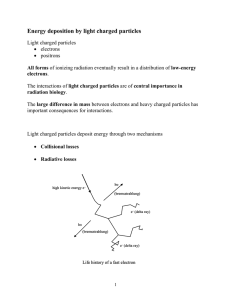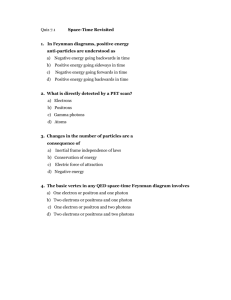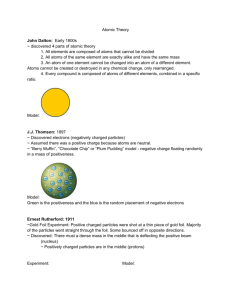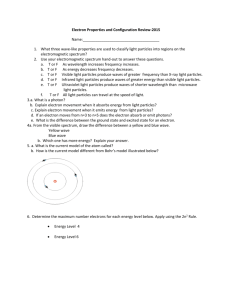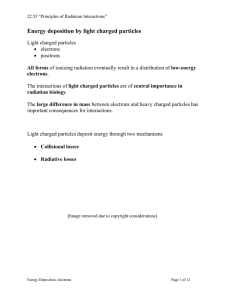Energy deposition by light charged particles
advertisement
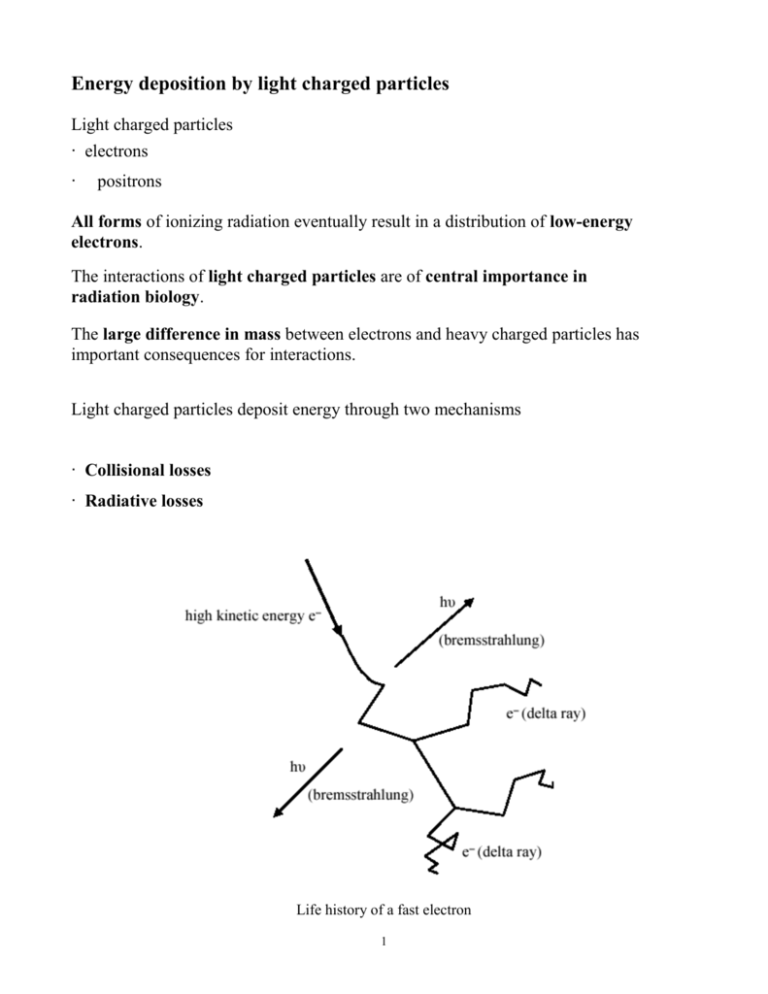
Energy deposition by light charged particles Light charged particles ‧ electrons ‧ positrons All forms of ionizing radiation eventually result in a distribution of low-energy electrons. The interactions of light charged particles are of central importance in radiation biology. The large difference in mass between electrons and heavy charged particles has important consequences for interactions. Light charged particles deposit energy through two mechanisms ‧ Collisional losses ‧ Radiative losses Life history of a fast electron 1 Collisional losses ‧ Electrons lose energy via interactions with orbital electrons in the medium. ‧ This leads to excitation of the atom or ionization. ‧ Energy loss via these mechanisms is called “collisional loss”. ‧ Maximum energy transfer occurs in a “head-on” collision between two particles of masses m and M: and can be expressed as Qmax = 4mME ( M+m ) 2 where E is the kinetic energy of the incident particle. With light charged particles, m = M and so Qmax = E. ‧ The electron collides with a particle of identical mass and thus large scattering angles are possible. ‧ This results in a track that is very tortuous instead of the straight path of a heavy charged particle. 2 Radiative Losses: bremsstrahlung A second mechanism of energy loss is possible because of the small mass of the light charged particle (negligible with HCPs). A charged particle undergoing a change in acceleration always emits “radiative” electromagnetic radiation called bremsstrahlung. The larger the change in acceleration, the more energetic the bremsstrahlung photon. For electrons, the bremsstrahlung photons have a continuous energy distribution that ranges downward from a maximum equal to the kinetic energy of the incoming electron. The efficiency of bremsstrahlung in elements of different atomic number Z varies nearly as Z2. Thus, for beta particles of a given energy, bremsstrahlung losses are considerably greater in high-Z materials, such as lead, than in low-Z materials, such as water. ‧ Bremsstrahlung increases with electron kinetic energy. 3 ‧ Bremsstrahlung increases with atomic number, Z. Stopping Power As with heavy charged particles the stopping power is the linear rate of energy loss due to excitations and ionizations (“collisional energy loss”). The collisional stopping-power for electrons and positrons can be written This equation looks somewhat similar to the stopping power equation for heavy particles but now the particle charge is 1, so -dE/dx is proportional to n/v2. The stopping power of a medium for an electron or positron is: ‧ proportional to the density of electrons in the material and ‧ inversely proportional to the particle energy Tthe total stopping power for light charged particles is equal to the sum of both collisional and bremsstrahlung stopping powers. There is no simple analytic expression for calculating energy loss via bremsstrahlung (but it is easier to measure). 4 The collisional energy-loss rate in an element is proportional to n and hence to Z. The radiative energy-loss rate increases logarithmically and at high energies becomes the predominant mechanism of energy loss for beta particles. 5 Radiation Yield Radiation yield, Y, is defined as the average fraction of its energy that a beta particle radiates as bremsstrahlung in slowing down completely. ‧ Radiation yield increases with electron kinetic energy. ‧ Radiation yield increases with atomic number, Z. Y= 6 x 10-4ZT 1 + 6 x 10-4ZT An estimate of radiation yield can give an indication of the potential bremsstrahlung hazard of a beta-particle source. To limit the bremsstrahlung yield, low Z materials (e.g., aluminum) should be used as shielding for betas and electrons since Y increases with Z. At very high energies, the dominance of radiative over collisional energy losses gives rise to electron-photon cascade showers. 6 ‧ High-energy beta particles emit high-energy photons. ‧ These, in turn, produce Compton electrons and electron-positron pairs. ‧ These, in turn, produce additional bremsstrahlung photons, etc. Range Two factors complicate range as applied to electrons. ‧ If Y is high, then the ‘range’ of the energy associated with the initial incident particles is large indeed due to the very large mean free path of photons. ‧ Second, since electrons do not have a straight path, it is necessary to distinguish between distance traveled and penetration distance. Empirical equations for electron range in low-Z materials. R = range in g cm-1 T = kinetic energy of the electron For : 0.01 ≤ T ≤ 2.5 MeV R = 0.412T 1.27-0.09541Nt 1nT = 6.63-3.24(3.29-1nR)½ For : T > 2.5 MeV 7 R = 0.530T –0.106 T = 1.89 R+0.2 Examples Of Electron Tracks In Water Electron tracks can be simulated using known probability distribution functions and Monte Carlo techniques to calculate ‧ energy loss per interaction, ‧ scatter angle, and ‧ distance to next interaction, Individual particles are tracked until their energies are below the threshold for electronic excitation (7.4 eV for water). Note the “tortuous” path of an electron due largely to the large angle scattering possible with each collision. At higher energies, scattering tends to be more forward directed, at low energies (e.g. near the end of the track) scattering is almost isotropic. This is in contrast to the tracks of heavy charged particles. Calculated tracks (projected into the plane of the figure) of 800 keV electrons in water. [Turner, 1995] 8 Three calculated tracks of 5-keV electrons in water. Each electron starts from the origin and initially travels along the horizontal axis toward the right. Each dot gives the position of an energy deposition event. Delta rays are secondary electrons with enough energy to leave the local vicinity of the track and make a track of its own. Both light and heavy charged particles traveling through matter sometimes produce delta rays. A delta ray can also create another delta ray. Calculated track segments (0.7 μm) of protons and alpha particles having the same velocities in water. 9 Positrons ‧ The coulomb forces that result in the major mechanism of energy loss (“collisional”) for light charged particles exist regardless of the charge on the particle (i.e. electron or positron). ‧ Whether the interaction involves a repulsive (electron-orbital electron) or attractive (positron-orbital electron) force, the energy transfer is about the same. ‧ Thus, the tracks of positrons in a material are similar to those of electrons, and the stopping powers and range are also roughly the same, for the same initial energies. At or near the end of the positron range, the positron combines with a negative electron in the material and the two particles annihilate. The combined rest mass energy is converted into two 0.511 MeV photons traveling in opposite directions. These photons are very penetrating and lead to deposition of energy far from the original positron track. 10 Electron-positron pair annihilation and the creation of two photons. 11
